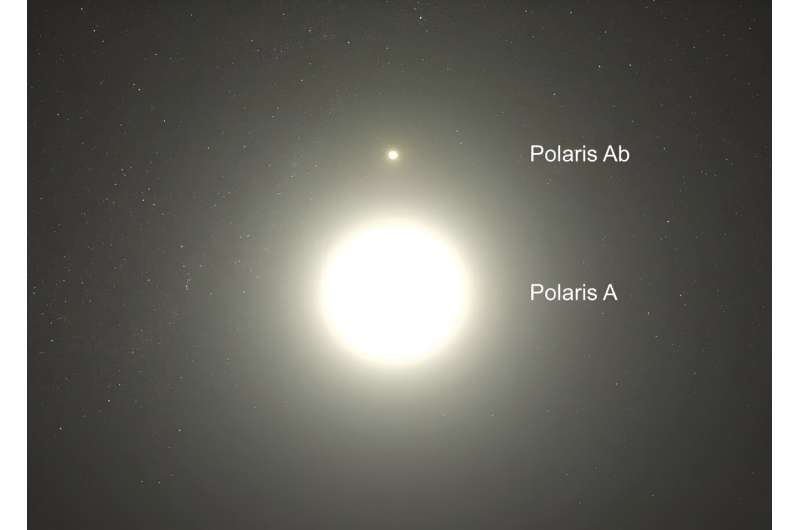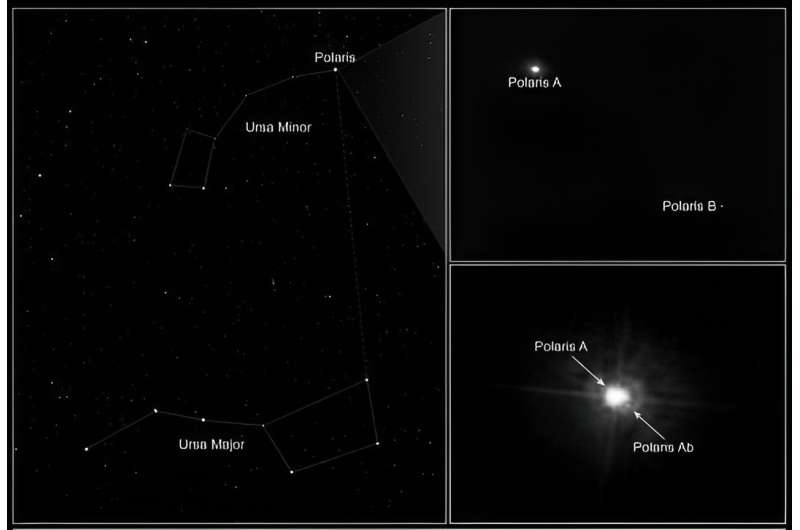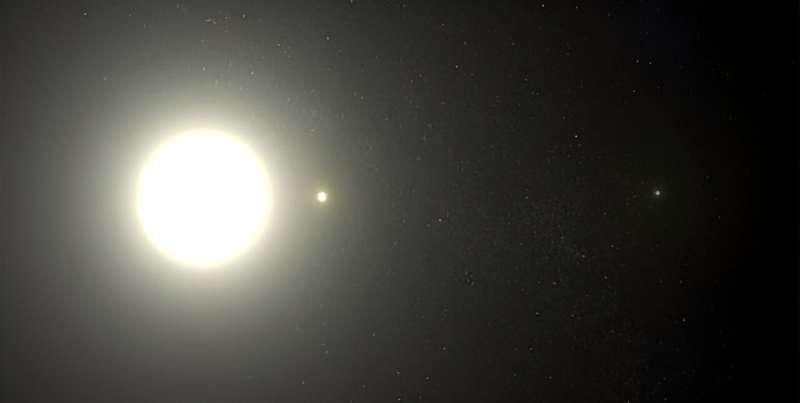This article has been reviewed according to Science X's editorial process and policies. Editors have highlighted the following attributes while ensuring the content's credibility:
fact-checked
preprint
trusted source
proofread
Polaris is the closest, brightest cepheid variable. Very recently, something changed

When you look up in the night sky and find your way to the North Star, you are looking at Polaris. Not only is it the brightest star in the Ursa Minor constellation (the Little Dipper), but its position relative to the north celestial pole (less than 1° away) makes it useful for orienteering and navigation. Since the age of modern astronomy, scientists have understood that the star is a binary system consisting of an F-type yellow supergiant (Polaris Aa) and a smaller main-sequence yellow dwarf (Polaris B). Further observations revealed that Polaris Aa is a classic Cepheid variable, a stellar class that pulses regularly.
For most of the 20th century, records indicate that the pulsation period has been increasing while the pulsation amplitude has been declining. But recently, this changed as the pulsation period started getting shorter while the amplitude of the velocity variations stopped increasing. According to a new study published on the arXiv preprint server by Guillermo Torres, an astronomer with the Harvard & Smithsonian Center for Astrophysics (CfA), these behaviors could be attributed to long-term changes related to the binary nature of the system, where the two stars get closer to each other, and the secondary perturbs the atmosphere of the primary.
Cepheid variables are stars that pulsate radially, causing them to vary in diameter and temperature. These pulsations are directly related to changes in their brightness, which makes them a useful tool for measuring galactic and extragalactic distances. The variable nature of Polaris was confirmed in 1911 by Danish astronomer Ejnar HertzsDaprung, for whom the Hertzsprung–Russell diagram is partly named. Observations conducted throughout the 20th century have shown that Polaris has a consistent pulse period of about four days, which has been steadily increasing every year.

As Dr. Torres explained to Universe Today via email, this recently began to change, leading many astronomers to question what is driving Polaris' pulsations. "For more than 150 years and up until about 2010, the period had been getting longer by about four or five seconds each year," he said. "Modern observations have shown that this trend has now reversed, and the pulsation period is getting shorter. This is an unexpected change, showing that there is still much that we do not understand about Polaris and other stars like it."
To learn more about Polaris' pulsation period, Torres consulted radial velocity (RV) measurements going back to 1888. This technique consists of measuring spectra from a distant star and looking for redshift and blueshift, which are indications that the star is moving back and forth (this technique also yields accurate estimates of its velocity). Torres' sample included more than 3,600 RV measurements, including the nearly 1,200 spectroscopic observations carried out by the Lick Observatory over more than 60 years.
This allowed Torres to trace the evolution of the pulsation properties of Polaris, which showed how often pulses occur and their amplitude as well. Said Torres:

"In the early 1990's the amplitude had become so small that it was thought that the pulsations were about to stop. However, Polaris decided otherwise, and by the late 1990's the amplitude had started to increase again, which lasted until about 2015. The most recent observations indicate the amplitude is no longer increasing, and may begin to come down again. Additionally, RVs have shown that this behavior may be related to the fact that Polaris is orbited by another star, which comes close to it every 30 years and may be perturbing the Cepheid's outer layers, where the pulsations take place."
In short, the changes in Polaris' pulsation period may result from its companion disturbing it whenever they make their closest pass to each other. Once this is factored in, Torres was able to derive an improved spectroscopic orbit for the binary system, something astronomers have been trying to resolve for generations. This could also lead to more accurate estimates of the dynamical masses of each stellar companion, which were also subject to uncertainty. As Torres summarized:
"We now know that Polaris behaves in an irregular and unpredictable manner. If it is confirmed that this has to do with the presence of its companion, this may shed light on the behavior of other pulsating stars with similar properties and help us understand the nature of the oscillations. It is therefore important to keep an eye on it, as it may still hold surprises for us."
More information: Guillermo Torres, The Spectroscopic Orbit of Polaris, and its Pulsation Properties, arXiv (2023). DOI: 10.48550/arxiv.2309.03257
Journal information: arXiv
Provided by Universe Today





















